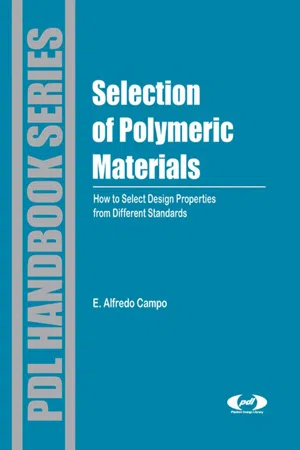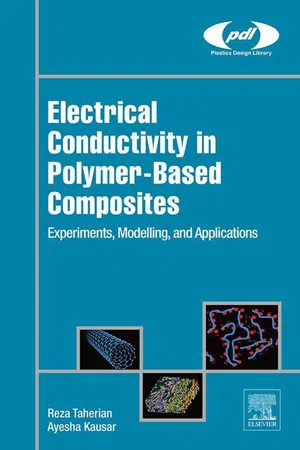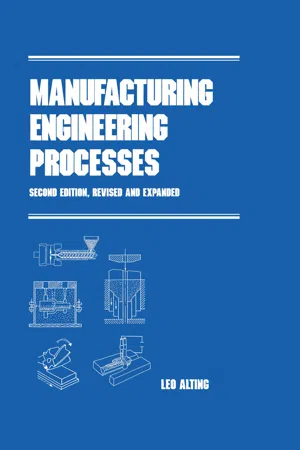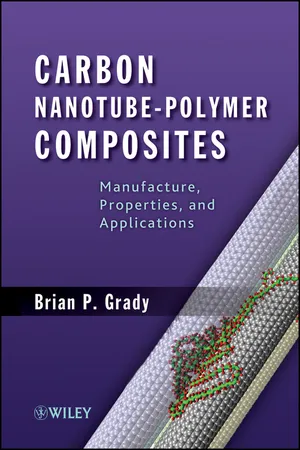Electrical Properties of Materials
The electrical properties of materials refer to their behavior in response to an electric field. These properties include conductivity, resistivity, dielectric constant, and band gap. Conductive materials allow the flow of electric current, while insulating materials resist the flow of current. Semiconductors have properties between those of conductors and insulators, making them essential for electronic devices.
8 Key excerpts on "Electrical Properties of Materials"
- David C. Jiles(Author)
- 2017(Publication Date)
- CRC Press(Publisher)
...We begin on the level of a few electrons subjected to an electrostatic potential due to the rest of the material. Subsequently the bulk properties of materials are considered and the phenomena are related to the earlier discussion of the behaviour of electrons. Finally several key applications are discussed, in which the electronic properties of materials play the central role in determining the suitability of materials for these applications. In particular the areas of microelectronics, optoelectronics, superconductivity, magnetism and piezoelectricity are examined....
- eBook - ePub
Selection of Polymeric Materials
How to Select Design Properties from Different Standards
- E. Alfredo Campo(Author)
- 2008(Publication Date)
- William Andrew(Publisher)
...4 Electrical Properties of Polymeric Materials 4.1 Introduction The purpose of this chapter is to provide sufficient information to allow the reader to understand the significance of the electrical test procedures, compare the electrical property values between several potential polymers that meet the application requirements, and provide process assistance in making the appropriate polymeric material selection for electrical product application. Materials such as wood, glass, fabrics, mineral oil, and ceramics were originally used for electrical product applications to provide mechanical structure support, shielding, and insulation between the electrically live components and the ground. As the electrical/electronics industry grew, so did the need for an alternative material that possessed the desired electrical, thermal, and mechanical properties and could be produced economically. The advent of new high performance engineering polymeric materials has assisted in the development and applications of electrical/electronic components. The combination of characteristics such as ease of fabrication, low cost, lighter weight, and excellent insulation properties has made plastics one of the most desirable materials for electrical applications. Polymeric materials are now specified in a majority of applications requiring resistance to extreme temperatures, chemicals, moisture, and stress. In electrical/electronic applications, polymeric materials usually serve a selective insulation or signal transmission function, which is frequently combined with a structural purpose. The important properties and characteristics of polymeric materials can be grouped into two basic categories: the insulation or dielectric properties and the service temperature index classifications...
- eBook - ePub
Electrical Conductivity in Polymer-Based Composites
Experiments, Modelling, and Applications
- Reza Taherian, Ayesha Kausar(Authors)
- 2018(Publication Date)
- William Andrew(Publisher)
...12 Methods of Measuring Electrical Properties of Material * Mohammad Matboo Ghorbani and Reza Taherian, Faculty of Chemical & Materials Engineering, Shahrood University of Technology, Shahrood, Iran Abstract In this chapter the common-type methods for measuring the electrical conductivity in different categories of materials have been described. At first the methods for determining surface resistivity, bulk resistivity, and contact resistance of materials especially composites have been discussed. In addition, two-probe and four-probe methods, their differences, and common errors for two-probe and four-probe methods have been illustrated. Moreover, in the electrical tests for insulator materials and semiconductors with related formulations have been explained. Lastly the methods for determining the electrical conductivity of metals and conductors have been introduced. Keywords Two probe; four probe; contact resistance; determining electrical conductivity; surface conductivity; bulk conductivity 12.1 Introduction The Electrical Properties of Materials are different; some are good electrical conductors (e.g., metals), whereas some others are good insulators (e.g., plastics). There is no single technique or instrument that can measure electrical properties of all types of materials. Electrical properties is a key physical property of all materials. It is often necessary to accurately measure the resistivity of materials. The focus of this chapter is to describe a number of different experimental techniques for measuring electrical resistivity. We begin with the basic concepts of electrical conductivity and then classifying the materials by electrical resistivity. This classification is related to conductors, semiconductors, and insulators. The focus of this chapter is on explaining how to make practical resistivity measurements for each mentioned group and explain some common experimental errors...
- eBook - ePub
Nanoparticles - Nanocomposites – Nanomaterials
An Introduction for Beginners
- Dieter Vollath(Author)
- 2013(Publication Date)
- Wiley-VCH(Publisher)
...10 Electrical Properties 10.1 Fundamentals of Electric Conductivity; Diffusive versus Ballistic Conductivity In a conventional metallic conductor, there is a huge number of electrons; after connecting a voltage, they move slowly from one to the other end of the wire. This is rather a drift than a directed movement. The electrons moving under the influence of an electrical field experience scattering processes leading to a change in momentum by interactions with electrons, phonons, impurities, or other imperfections of the lattice. These processes are responsible for the electric losses. Figure 10.1 displays these phenomena in a simplified way, where an Ohm ic conductor, for example, a metallic wire, is connected to an electric circuit, electrons are moving driven by the applied electric field. Figure 10.1 Electrical conduction mechanism in conventional metallic conductors. Diffusive conductance, active in this case, is characterized by scattering of free electrons in the conductor. Electric current is transported by free electrons performing a drift movement. The conventional process of electric conductivity called “diffusive conductance” is ruled by Ohm 's law (10.1) In Eq. (10.1), the quantity V is the applied voltage, I the electrical current, R the resistance, and G the electrical conductance. The validity of Ohm 's law implies that the electrical resistance depends only on the geometry and material of the conductor. The conductance of a wire depends on the geometrical parameters l, the length, and a, the cross section:. The electric conductivity σ is a material parameter. For metallic conductors the conductivity is independent of the applied voltage and the electric current, for semiconductors or insulators, the electric conductivity usually increases with increasing applied voltage. Wires with dimensions in the nanometer range or molecular dimensions do not follow Ohm 's law in any case...
- Alting(Author)
- 2020(Publication Date)
- CRC Press(Publisher)
...2 Properties of Engineering Materials 2.1 INTRODUCTION For engineers to be able to select a suitable material fulfilling the functional requirements of a component (determined from the performance and economical production requirements), they must have a broad knowledge of: The properties of the materials available The manufacturing possibilities, including: The suitability of the materials for the various processes (i.e., the important properties affecting processing) The effects of the various processes on the material properties The economics of the various material-process combinations Only by considering these relationships coherently can a satisfactory selection be made. This means that it is not sufficient to choose the cheapest material that would satisfactorily perform the functions desired, because it may be very ex pensive to process. The functional properties of a material can be evaluated only when the manufacturing processes have been selected, as the processes normally change the properties. Certain mechanical, physical, and metallurgical changes are generally brought about; some beneficial and others detrimental. This change in properties may sometimes allow the choice of a cheaper material than if the functional requirements alone were considered. 2.2 MATERIAL PROPERTIES The properties of materials may be divided into the following four groups: 1. Physical properties 2. Chemical properties 3. Mechanical properties 4. Manufacturing properties Physical properties include color, density, melting point, freezing point, specific heat, heat of fusion, thermal conductivity, thermal expansion, electrical conductivity, magnetic properties, and so on. Of the chemical properties, corrosion resistance plays an important role in the choice of materials and generally includes resistance to chemical or electro-chemical attack...
- eBook - ePub
Material Selection for Thermoplastic Parts
Practical and Advanced Information
- Michel Biron(Author)
- 2015(Publication Date)
- William Andrew(Publisher)
...12 Electrical Properties Abstract According to the recent studies, about 60% of plastics failures come from a wrong selection of the used plastic grade. This chapter aims helping to define electrical requirements that must be selected among the most common electrical properties: (1) The volume resistivity: more than 250 examples between less than 1 and 10 18 Ω-cm. The most common applications need electrical insulation but the most demanding uses relate to more or less better conductive plastics; (2) Permittivity or dielectric constant: more than 180 examples from 2 up to 32; (3) Loss or dissipation factor or tangent: more than 170 examples from 10 − 4 up to more than 10 − 1 ; (4) Dielectric strength: more than 150 examples from 1 kV/mm up to more than 60 kV/mm; (5) Arc resistance (more than 50 examples). Forty-four electrostatic dissipative compounds are compared to general-purpose grades based on the same polymer for surface or bulk resistivity or resistance. Some examples briefly highlight the effects of frequency, temperature, and moisture on the main electrical properties. At the end, a specific section gives information concerning formulation to make thermoplastics conductive. Keywords Conductive; Dielectric; Dissipation; Electrical; ESD; Permittivity; Resistivity Outline 12.1 Volume Resistivity 480 12.2 Relative Permittivity or Dielectric Constant 489 12.3 Alternating Current Loss Tangent or Loss Factor 496 12.4 Dielectric Strength 496 12.5 Surface Resistivity 502 12.6 Arc Resistance 508 12.6.1 Arc Resistance (D495) 508 12.6.2 Comparative Tracking Index 511 12.6.3 High-Voltage Arc...
- eBook - ePub
Plastics
Microstructure and Engineering Applications
- Nigel Mills, Mike Jenkins, Stephen Kukureka(Authors)
- 2020(Publication Date)
- Butterworth-Heinemann(Publisher)
...Chapter 12 Electrical properties Abstract Polymers have widely been used for many years as electrical insulators where their flexibility and mouldability gives them immediate advantages over ceramics, which are also widely used as insulators. Polymers can be processed into thin insulating films, or polymeric layers can be used to isolate electrical circuits. In many cases the mechanical or thermal product requirements are more important than electrical strength in determining, for instance, the required thickness of an insulating layer; nevertheless ceramics do have higher temperature resistance. However, recently conducting polymers have become available and a whole new area of technology called polymer electronics (or often ‘plastic electronics’) is developing. In this chapter we will begin by briefly reviewing the development of conducting polymers, the recent successes of polymer electronics and some promises for future applications. The chapter then considers electrical insulation in detail before exploring the dielectric response of polymers exposed to high frequency electrical signals...
- eBook - ePub
Carbon Nanotube-Polymer Composites
Manufacture, Properties, and Applications
- Brian P. Grady(Author)
- 2011(Publication Date)
- Wiley(Publisher)
...Chapter 6 Electrical Properties 6.1 Overview The term “cheap plastic” is a term of derision that I personally have used when a polymer piece breaks that is the key to proper function of something important (like the holder for my dishwasher basket!). Along with their low cost and their maddening habit of breaking at inopportune times, polymers are also well known for their electrically insulative properties. There are a few polymers, the discovery of which led to the awarding of the Nobel Prize for Chemistry in 2000, that are electrically conductive or semiconductive, but the vast majority of polymers are electrically insulative. However, some applications, such as currentMain_Text limiters, electrostatic dissipation devices, and electromagnetic interference shielding, require significantly higher electrical conductivities than an electrically insulative polymer can provide. Although a highly conductive metal might be suitable for some of these applications, cost and weight considerations often preclude their use. Electrically conductive polymers also tend to be very costly and are extremely difficult to process and form into complex shapes. Further, electrically conductive polymers tend to be brittle and not very resistant to environmental conditions such as high humidity. For these reasons, when electrical conductivity is required for a polymer, a common procedure is to mix a polymer with conductive filler. Usually, carbon black or metals are used as conductive fillers. Carbon nanotubes are also a suitable filler for applications that require electrical conductivity. Electrical conductivity (σ) has units of current/(voltage × distance), which in SI (metric) units is ampere/(volt × meter). The unit ampere/volt is termed siemens, so the SI units of electrical conductivity are siemens/meter (S/m)...







